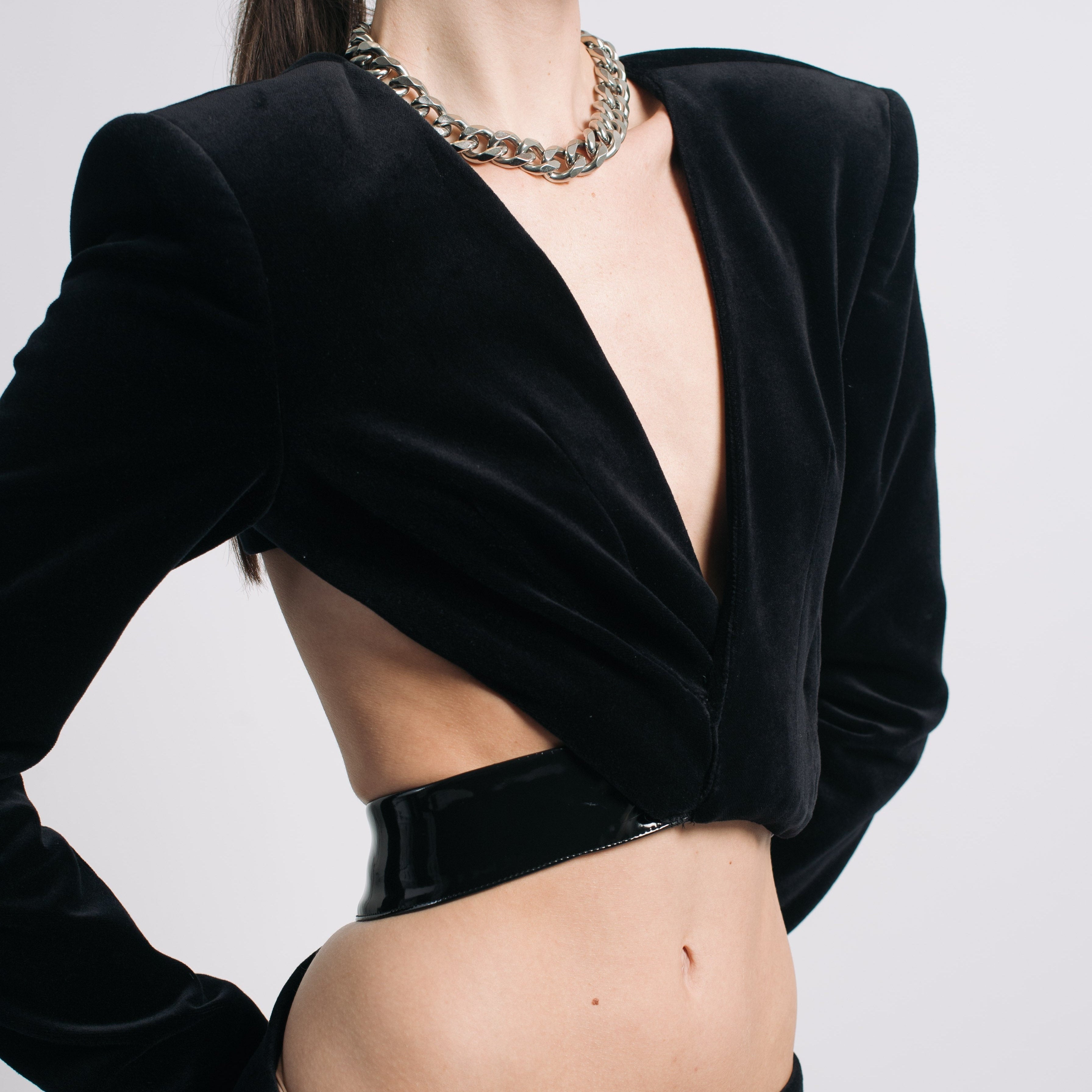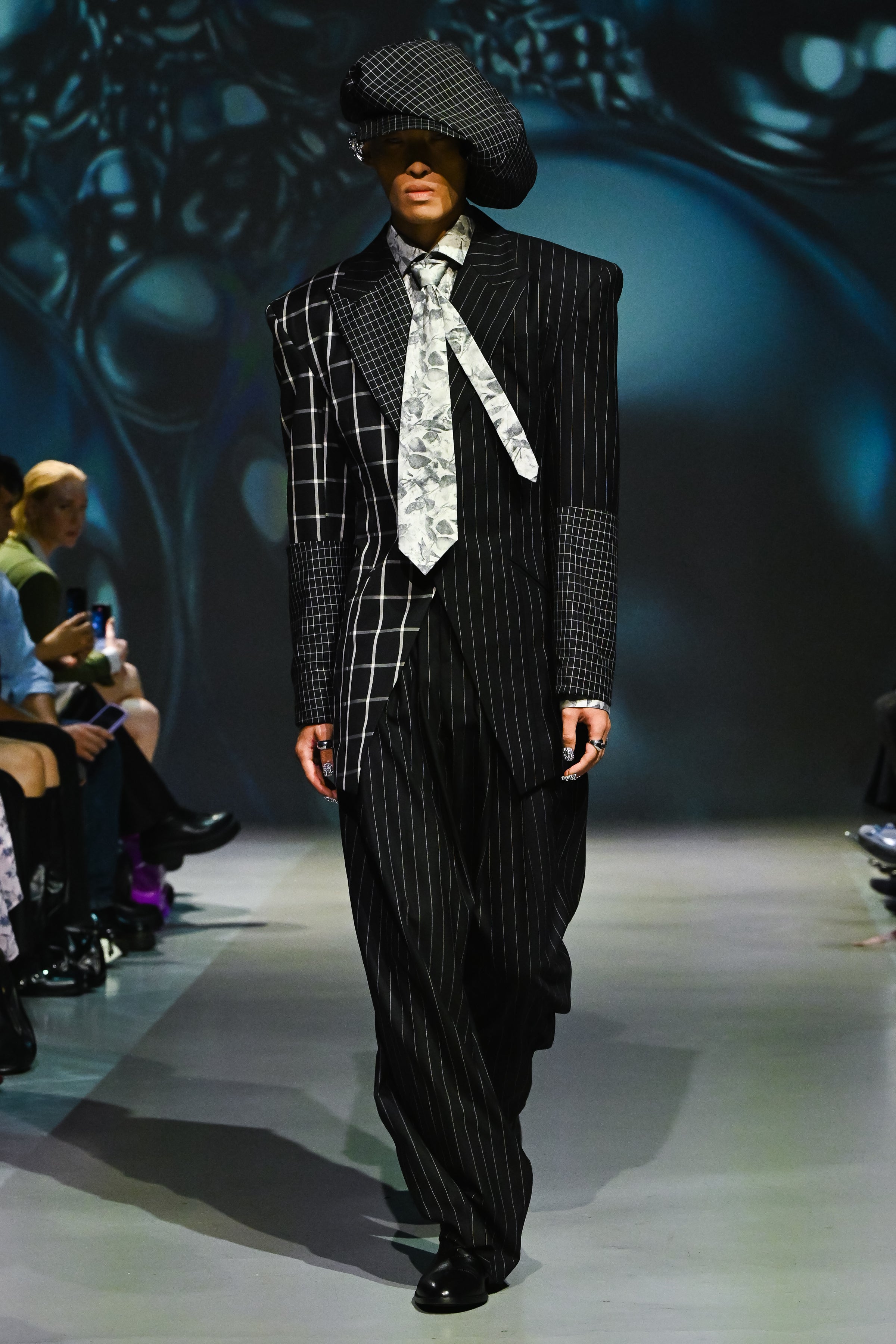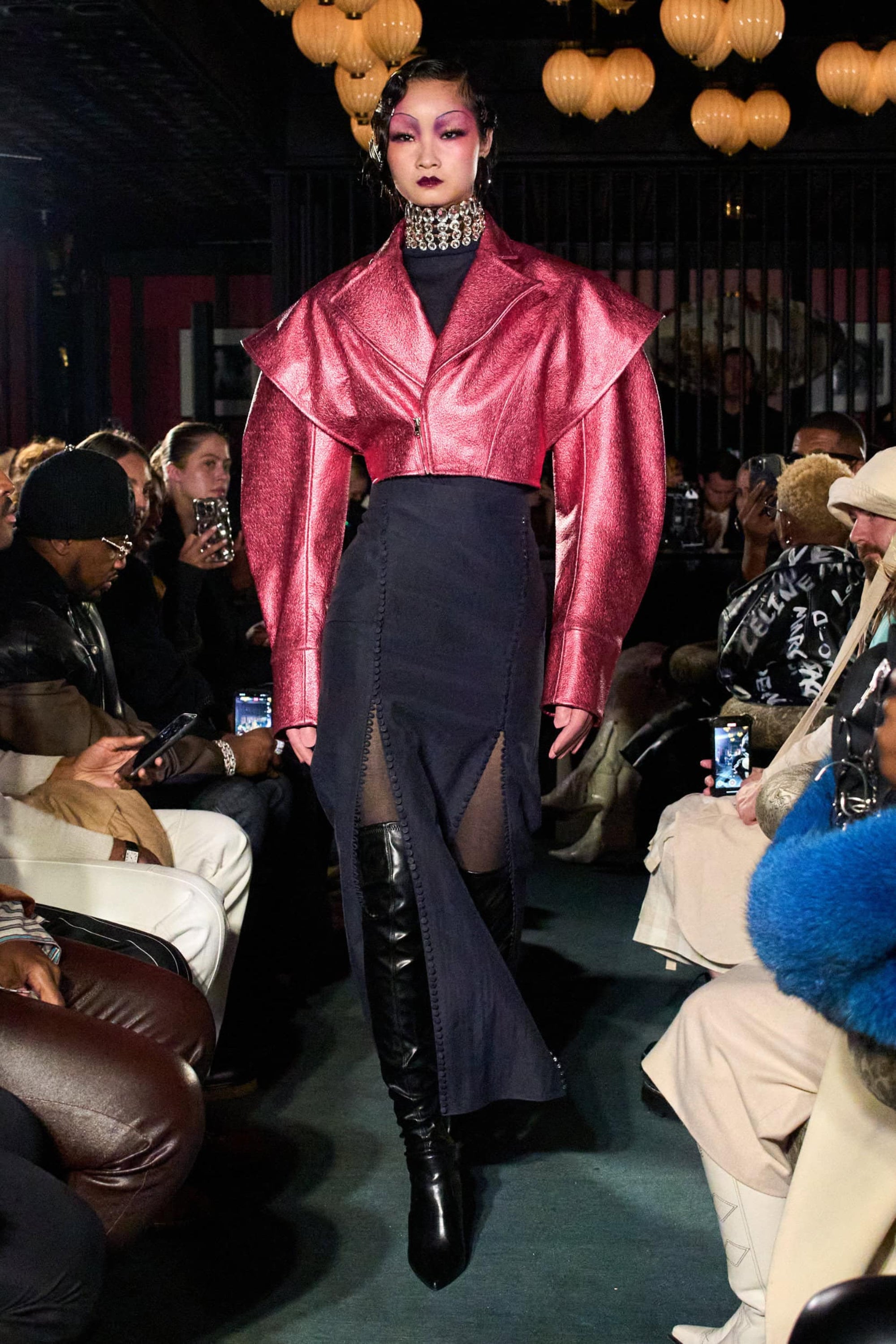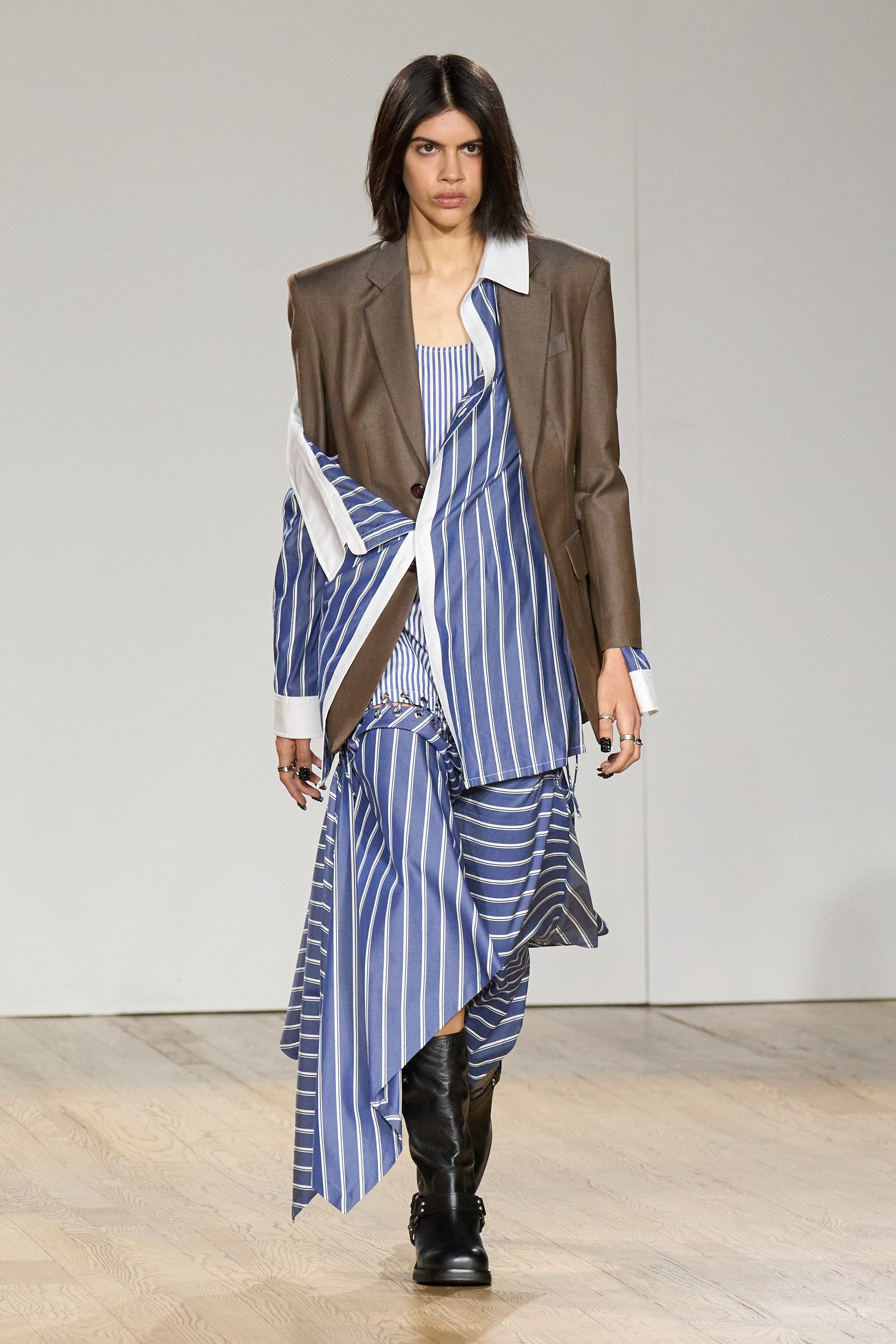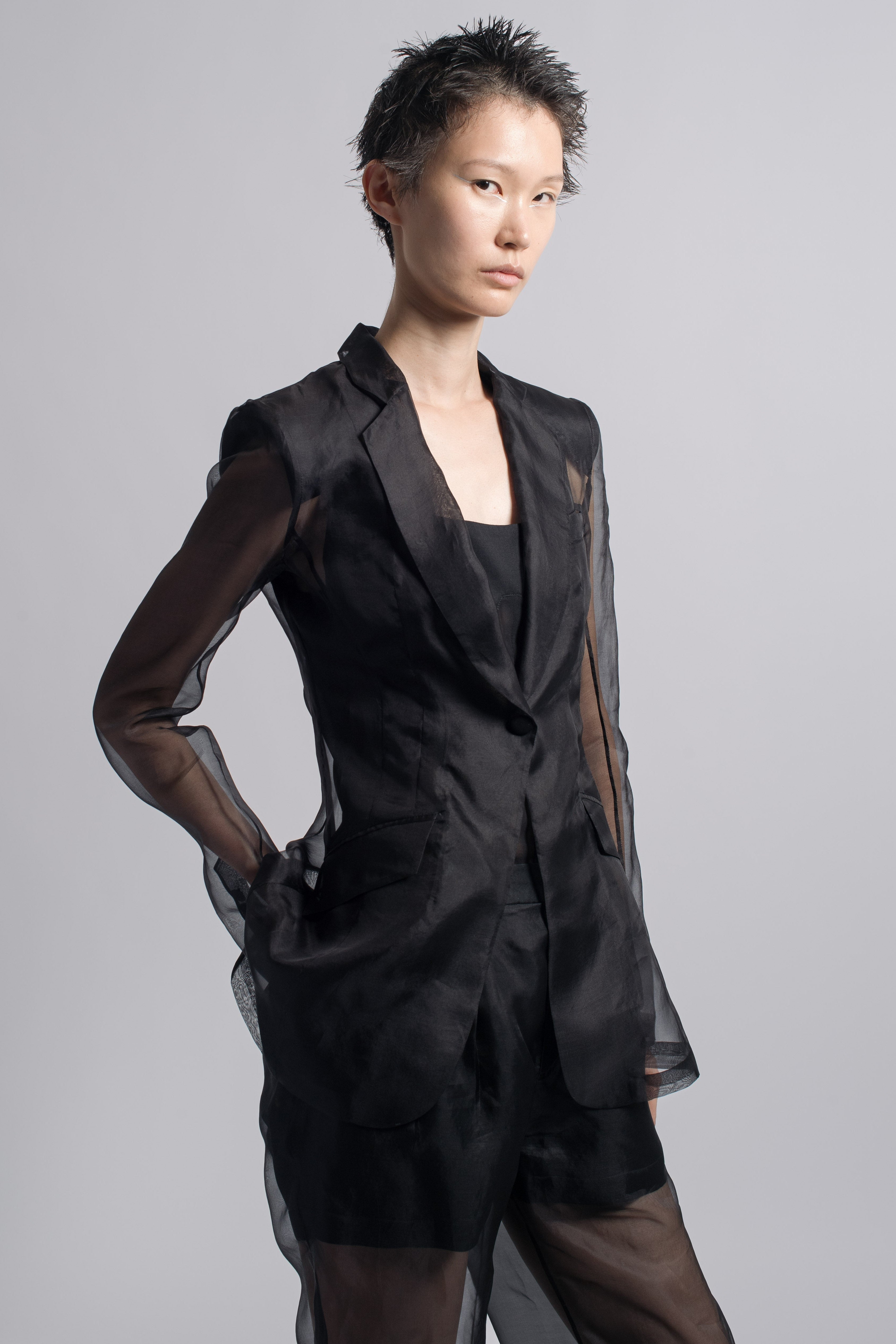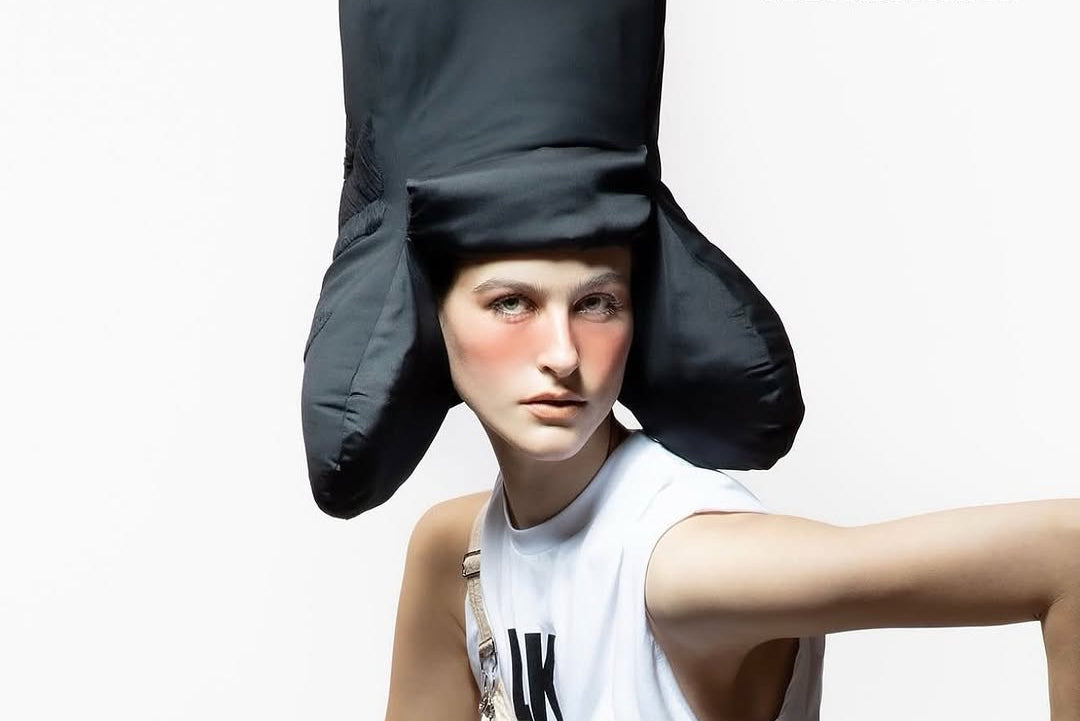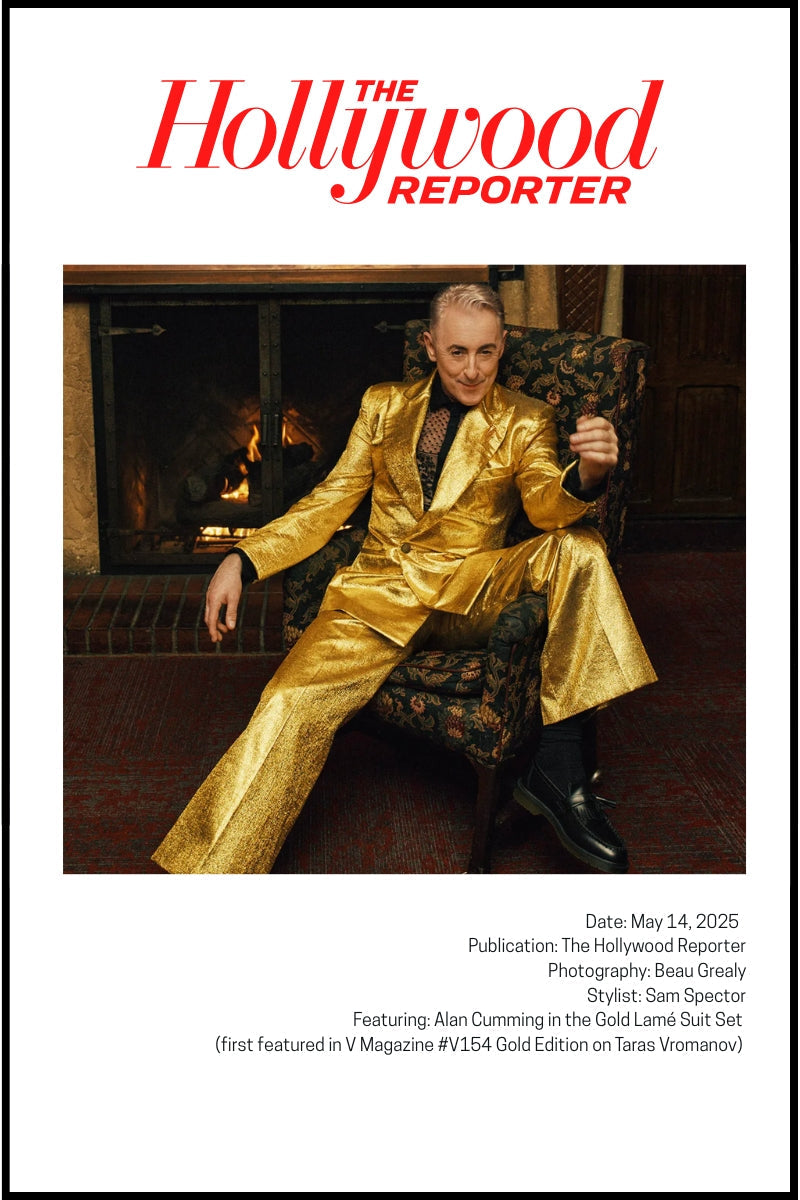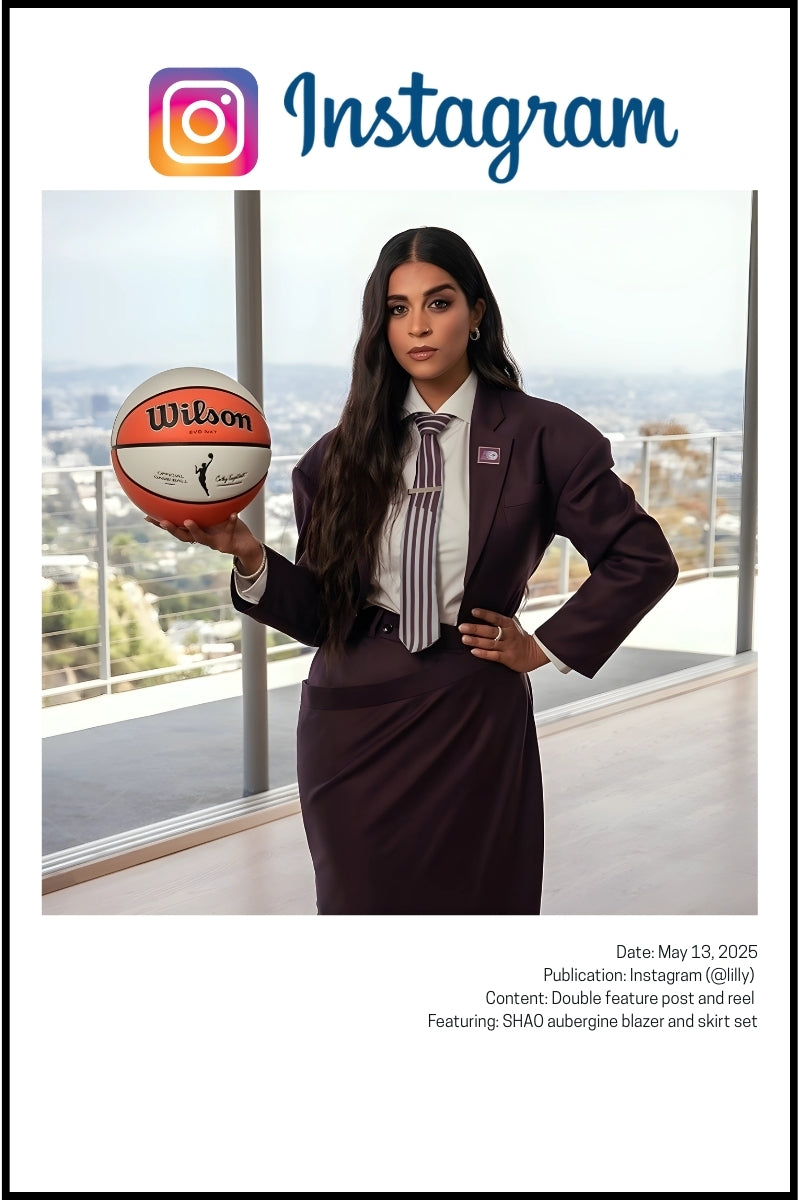WHEN BROADWAY'S BRIGHTEST MEETS SHAO'S ARCHITECTURAL REBELLION
Four Tony nominations running. That's the kind of streak that makes people pay attention—not just to the work, to the presence. Kara Young moves through theater districts and editorial shoots with the confidence of someone who knows exactly what she's building, piece by careful piece.
Paper Magazine caught her at the perfect moment. Timothy Greenfield-Sanders behind the lens, Michael Musto asking the right questions, and Young wearing SHAO's Dark Indigo Structured Denim Dress from the Shanghai 1930s collection like it was tailored for this exact conversation. Sometimes fashion and timing align in ways that reveal more than intended.
The magazine calls their Tony feature "Give It Everything Or Die Trying"—dramatic enough for Broadway, real enough for anyone who's ever fought for recognition in a city that hands out nothing for free. Young's latest nomination comes from her role as Aziza in Branden Jacobs-Jenkins's Purpose, playing the friend who watches family dysfunction unfold with "half smile and eyes popped open." It's a role that requires presence without dominance, authority without aggression—the kind of theatrical balance that translates directly into how she approaches everything else.
Street Theater: Where Harlem Meets the Bund
Young's Harlem roots show up in unexpected places. When Musto asks about her spirit animal, she doesn't hesitate: "New York City! Whenever I spent time with cousins in New Jersey, it was too quiet!" That restless urban energy infuses every choice she makes, from character development to what she wears when the cameras are rolling.
The SHAO dress captures something about that energy—structured enough for editorial photography, raw enough to reference the streets that shaped her. The Shanghai 1930s collection draws from a different kind of urban sophistication, when East met West in jazz clubs where power was negotiated through precision rather than volume. Young's selection bridges those worlds without forcing the connection.
Phylicia Rashad directs Young in Purpose, and their collaboration reveals how both women approach their craft. Young describes the process: "I'm constantly looking for notes and direction, in continually trying to excavate or keep adding new ingredients to the gumbo of someone's life." That appetite for complexity shows up in her fashion choices—pieces that work on multiple levels, carry multiple conversations, resist simple categorization.
The play itself deals with heavy material. Family as luxury, survival as achievement, the weight of holding space for people who might not make it through intact. Young repeats the line that haunts her most: "There was a time in this country, not too long ago, when the God-given right to family was considered a luxury for those who looked like us." In a context like that, what you wear to represent the work carries different weight.
Technical Rebellion: How Denim Becomes Architecture
The Dark Indigo Structured Denim Dress isn't trying to be evening wear—it's rewriting the rules about what denim can accomplish when treated with serious construction techniques. Floor-length proportions demand internal structure that most casual fabrics can't support, requiring boning placement adapted from couture techniques.
The color tells its own story. Multiple indigo washes create depth that photographs with dimension under professional lighting while maintaining the democratic associations denim carries from its workwear origins. The contrast stitching follows geometric patterns that reference Art Deco design language—sharp angles and clean lines that defined 1930s Shanghai's architectural identity.
French seams throughout create interior finish that distinguishes luxury construction from mass production shortcuts. The collar proportions balance traditional shirt dress references with the dramatic scale necessary for floor-length silhouettes. Each fabric-covered button maintains visual integration while providing functional closures that actually work during extended photo sessions.
The sleeves deserve particular attention. Cut to create broader shoulder line than typical denim jackets, with armhole placement that establishes lifted posture essential for editorial photography. The construction creates commanding silhouette while maintaining flexibility necessary for natural movement—technical achievement that shows up in every frame Greenfield-Sanders captured.
Young's comfort in the piece translates through the images. She moves like someone who trusts what she's wearing, understanding how construction supports rather than constrains presence. That confidence comes from experience—theater teaches you how clothing affects performance, how silhouette influences movement, how construction quality determines whether garments work with you or against you.
Cultural Synthesis: When References Have Depth
The Shanghai 1930s collection isn't costume history—it's cultural archaeology. That era represented unique synthesis moment when Chinese tradition intersected with international commerce, creating hybrid aesthetic that influenced everything from architecture to social navigation. The city's women developed power dressing strategies that combined Eastern silhouette precision with Western tailoring techniques.
Young's selection creates contemporary dialogue with that historical moment. Her Harlem background intersects with the collection's Shanghai references to produce something entirely new—not appropriation, not nostalgia, genuine cultural conversation that honors both influences while creating fresh meaning.
The denim foundation provides democratic counterpoint to 1930s Shanghai's exclusive luxury culture. Workwear associations coexist with couture-level construction, acknowledging different approaches to material value. Young's choice reflects generational shift in luxury consumption, where authenticity and cultural resonance matter more than traditional status markers.
Theater requires similar cultural navigation. Playing Aziza demands understanding multiple cultural codes simultaneously—family dynamics, generational trauma, survival strategies, artistic interpretation. Young brings that same complexity to fashion selection, choosing pieces that carry multiple conversations without reducing them to simple statements.
The timing of the Paper Magazine feature, coordinated with Tony nominations, creates permanent documentation of cultural moment that extends simple awards coverage. Young's choice to wear SHAO during recognition season establishes association between theatrical excellence and design innovation, positioning both within broader conversations about artistic integrity.
Editorial Chemistry: When Collaboration Actually Works
Greenfield-Sanders knows how to photograph power. His images capture both garment architecture and Young's commanding presence, creating frames that function as cultural documentation rather than simple fashion shots. The styling approach—minimal jewelry by Alexis Bittar—demonstrates understanding of how accessories enhance rather than compete with strong silhouettes.
Musto's interview technique gives Young space to reveal complexity rather than reducing her to sound bites. His questions about artistic process and theatrical ambitions provide context that elevates fashion choice into cultural commentary. When editorial and fashion collaborate effectively, both mediums achieve greater resonance.
The magazine's decision to feature Young in emerging designer pieces rather than obvious luxury brands reflects editorial sophistication about how fashion functions within contemporary cultural conversations. The choice supports both artistic documentation and designer development while avoiding transparent commercial arrangements.
Young's description of wanting to portray Mrs. Lovett from Sweeney Todd reveals appetite for characters that require psychological transformation through costume support. The SHAO dress's versatility—capable of appearing refined or rebellious depending on styling context—aligns with theatrical requirements for garments that adapt to evolving character needs.
Her theatrical background develops sophisticated understanding of collaborative fashion creation, where final result emerges through conversation between multiple creative visions. That openness translates into editorial work, where she can adapt to different visual languages while maintaining consistent aesthetic identity.
Material Philosophy: Democratic Luxury in Practice
SHAO's approach to denim challenges traditional fashion hierarchies that position certain materials as inherently superior. Using premium construction techniques on democratic fabric creates dialogue between different cultural values—accessibility and refinement coexisting rather than competing.
The transformation of workwear fabric through structured tailoring reflects contemporary understanding of luxury as achievement rather than inheritance. Young's comfort wearing formal denim demonstrates generational shift away from inherited status markers toward values-driven consumption that prioritizes meaning over obvious signaling.
The dress functions across diverse cultural contexts while maintaining couture-level craftsmanship standards. That versatility serves Young's career requirements, where single pieces must work for editorial shoots, awards documentation, and promotional obligations without compromising artistic narrative.
Denim's unique position within fashion hierarchy allows democratic associations to coexist with luxury potential through technical mastery and design innovation. Young's selection demonstrates sophisticated understanding of how material choices contribute to broader conversations about values and identity within entertainment industry.
The indigo treatment achieves specific color saturation that appears rich in print reproduction while remaining sophisticated in person—technical consideration essential for editorial work that serves both immediate documentation and long-term archival purposes.
Industry Navigation: Awards Season as Cultural Laboratory
The 2025 Tony Awards arrive during period of theatrical recalibration, where Broadway questions inherited assumptions about representation, authenticity, and artistic excellence. Young's four consecutive nominations position her within these broader industry conversations about cultural responsibility and individual achievement.
Awards season fashion typically functions as publicity extension, where clothing choices serve promotional objectives rather than artistic expression. Young's approach demonstrates alternative model, where fashion selection supports artistic narrative while contributing to broader cultural conversations.
Her choice to wear SHAO creates documentation of cultural moment that extends simple event coverage. The relationship between theatrical achievement and fashion influence operates within complex dynamics where authenticity competes with commercial opportunity, individual expression intersects with collective responsibility.
Purpose deals with themes that resonate through Young's entire approach to cultural navigation—family as achievement, survival as luxury, the weight of holding space for community healing. Her fashion choices during high-visibility moments reflect similar values, supporting emerging designers while serving aesthetic requirements.
The play's central question about family as luxury finds echo in Young's approach to luxury consumption—emphasizing craftsmanship and cultural resonance over obvious status signaling. Her selection demonstrates how individual choices can contribute to broader conversations about representation and values within entertainment industry.
Performance Integration: When Clothing Extends Character
Young's theatrical experience teaches sophisticated understanding of how costume functions as character development rather than decoration. This knowledge translates into fashion selection for editorial and awards documentation, where garment choice supports rather than distracts from artistic narrative.
Theater demands clothing that functions under various lighting conditions while supporting character development through multiple performances. These requirements develop understanding of how fabric, construction, and silhouette affect presence and movement—knowledge that serves editorial photography and awards season navigation.
The SHAO dress's architectural silhouette provides framework for commanding attention without demanding it—essential for awards season documentation where artistic achievement must register alongside industry politics. Young's comfort in structured pieces reflects understanding of how construction quality affects confidence and movement.
Her description of character development as "adding new ingredients to the gumbo of someone's life" parallels fashion's layering potential, where individual pieces accumulate meaning through context and combination. The approach serves both theatrical work and personal style development.
The relationship between theatrical costume and personal fashion becomes complex for performers whose public appearance contributes to career development. Young's selection of SHAO demonstrates understanding of how fashion choices during recognition moments contribute to long-term artistic positioning.
Cultural Capital: Style as Identity Architecture
Young's Harlem background provides foundation for understanding style as survival strategy and cultural expression simultaneously. The neighborhood's particular brand of sophistication—where presentation functions as both armor and art form—translates into fashion choices that work on multiple levels.
Her description of New York City as spirit animal articulates urban energy that requires sartorial architecture to reach full expression. The SHAO dress provides this architecture through structured silhouette that supports commanding presence while maintaining accessibility that connects with diverse audiences.
The dress's Shanghai inspiration filtered through Brooklyn craftsmanship and worn by Harlem artist creates cultural synthesis that defies simple categorization. This complexity reflects contemporary creative identity reality, where influences cross boundaries to create authentic individual expression rather than demographic targeting.
Young's approach during awards season demonstrates sophisticated understanding of how clothing choices contribute to representation conversations within entertainment industry. Her selection of emerging designers supports creative communities while serving aesthetic requirements—model for values-driven consumption that influences younger artists and audiences.
The balance between individual expression and collective responsibility becomes particularly complex when artistic success provides platform for cultural influence. Young's fashion choices during high-visibility moments create documentation that contributes to broader conversations about authenticity and artistic integrity.
Future Trajectories: Evolution in Motion
Young's fashion evolution suggests continued sophistication as theatrical recognition increases access to broader range of designers and styling resources. Her current choices demonstrate foundation of technical understanding and cultural literacy that typically improves with experience and exposure to different creative collaborations.
The relationship between Young and SHAO represents potential for sustained dialogue that serves both artistic and commercial interests while maintaining authentic cultural resonance. As her profile increases through theatrical success, fashion choices will likely influence broader conversations about style and artistic identity.
Her approach to luxury consumption—prioritizing craftsmanship and cultural meaning over traditional status markers—positions her as influence on younger artists navigating similar choices within contemporary entertainment landscape. The model demonstrates how individual decisions can contribute to industry-wide conversations about values and representation.
The intersection of theatrical excellence and fashion sophistication creates platform for cultural impact that extends celebrity influence into broader conversations about artistic integrity and authentic luxury consumption. Young's choices during recognition moments create documentation that accumulates cultural significance.
Yet questions remain about maintaining artistic authenticity as commercial opportunities increase and promotional obligations expand. The relationship between individual creative vision and industry expectations requires constant navigation, particularly for artists whose success provides platform for broader cultural influence.
The Question of Authentic Synthesis
Young's selection of SHAO for her Tony moment raises deeper questions about how contemporary artists navigate cultural expression through material choices that carry both aesthetic and political weight. When theatrical excellence meets design innovation in moments of recognition, both mediums reveal capacity for cultural commentary that transcends entertainment.
The dress's ability to support Young's artistic narrative while maintaining its own cultural integrity suggests possibilities for fashion that extend decoration or status signaling. When clothing becomes extension of artistic vision, both wearer and garment achieve resonance that serves broader cultural conversations.
The collaboration creates model for authentic engagement between fashion brands and cultural synthesis, where shared values of excellence and cultural navigation produce genuine dialogue rather than commercial arrangement. Young's comfort in the piece translates through documentation, creating imagery that serves both artistic archive and brand positioning.
The relationship between individual expression and collective responsibility becomes particularly complex when artistic success provides platform for influence beyond entertainment industry. Young's fashion choices during high-visibility moments contribute to conversations about representation, authenticity, and the responsibilities that accompany recognition.
When theater meets fashion in moments of cultural documentation, both mediums must navigate tensions between artistic integrity and commercial opportunity, authentic cultural dialogue and surface-level appropriation. Young's Tony season in SHAO's Shanghai denim creates one frame in ongoing conversation—leaving questions about how cultural synthesis can honor complexity while achieving genuine artistic success that resonates across different communities and contexts.

See Kara Young in SHAO for Paper Magazine
Check out the full editorial and Kara’s interview in Paper Magazine:
Read the article here
Images: Kara Young photographed by Timothy Greenfield-Sanders, styled in SHAO’s Dark Indigo Structured Denim Dress from the Shanghai 1930s collection.
